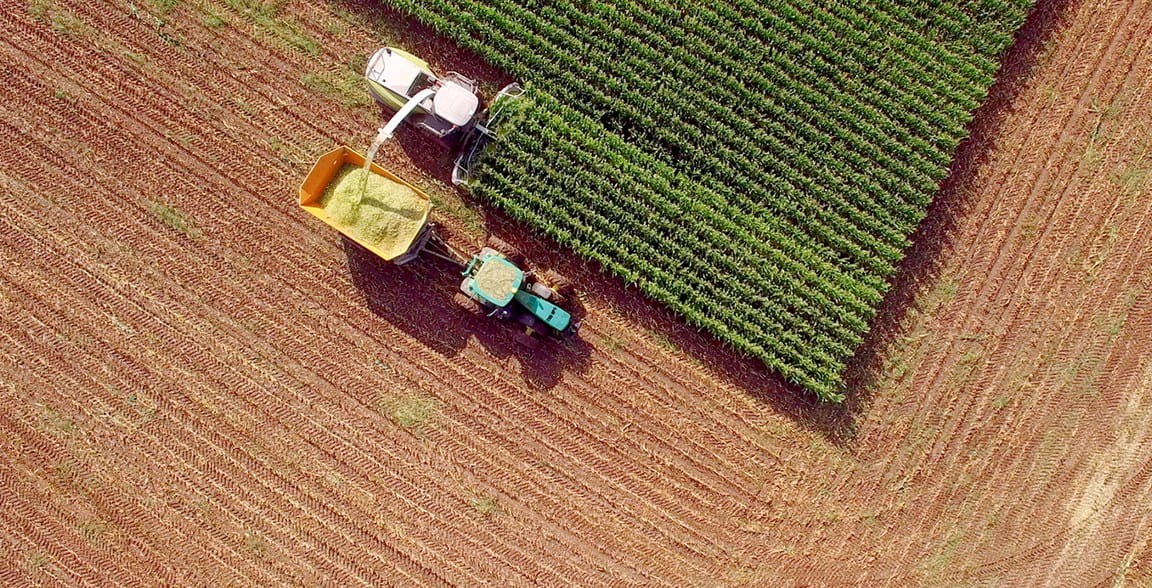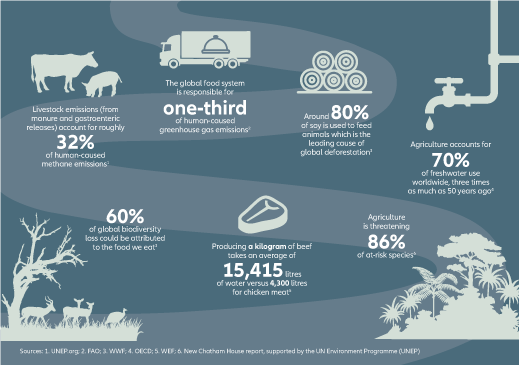The crisis on our plates: finding potential in failing food systems

Summary
The war in Ukraine has highlighted that the current way of producing and consuming food is unsustainable. As the rising global population places greater demands on our food system, there is an urgent need to build a resilient and inclusive food ecosystem, meeting both planetary and social needs. Opportunities exist for investors across the value chain of global food production and distribution to help mitigate these risks.
Key takeaways
|
Food is more than a simple source of nutrition – it supports human health, development and well-being. The challenge is that current food systems are failing on two fronts. They neither sustain the global population equitably nor maintain the natural regeneration of our ecosystem
Millions of people are undernourished at a time when roughly one-third of food produced is lost or wasted.1 Adding to this, the UN currently anticipates a global food crisis due to the situation in Ukraine. This comes amidst the most rapid inflation hikes for 20 years in some countries – one example being trade prices for vegetable oil jumping by almost 30%.
Without a systemic transformation, we risk failing to meet the targets set by the Paris Agreement and the UN Sustainable Development Goals (SDGs). Not only is the sector a high emitter of greenhouse gases (GHGs), but there is also the social impact of needing to feed an estimated population of 10 billion by 2050, more equitably and with greater resilience. Investors can play a role in directing capital towards building a more sustainable food ecosystem and supporting the shift towards a more inclusive, equitable future.
Greater inclusivity as core to a resilient and sustainable food system
![]()
Enough food is produced globally to meet the needs of an expanding population, whose average daily caloric intake has increased by 34% since 1947.2 Yet around 800 million people globally suffer from hunger and three billion cannot afford a healthy diet.3 We are currently off course to achieve the UN’s 2030 Zero Hunger target which stems from the universal right to adequate food.4 By 2030, 840 million5 are expected to suffer from hunger. At the other end of the spectrum, an estimated two billion are overweight or obese and at high risk of non-communicable diseases (NCDs). The global imbalance is clear
The challenge is not new but the Covid-19 pandemic, the invasion of Ukraine and increased frequency of extreme climate events have exposed the fragility of our food supply chain, and ultimately food insecurity. Ukraine is the source of millions of tonnes of maize and wheat that are key staples, especially in more vulnerable areas, such as South Asia and sub-Saharan Africa. Furthermore, women and young people are also disproportionately lacking in access to healthy and affordable food. Empowering them is essential to create a more inclusive food system that benefits everyone.
Achieving a deep transformation of food systems involves the recognition of their central role in contributing towards most of the 17 SDGs. Through powerful levers for transformation, sustainable food systems provide the opportunity for progress in achieving the SDGs by connecting society, environment and the global economy.
“Global food production threatens climate stability and ecosystem resilience. It constitutes the single largest driver of environmental degradation and transgression of planetary boundaries.”
Source: Professor Dr Johan Rockström, EAT-Lancet Commission, January 2019
Exhibit 1: the central role of food – touching upon each of the 17 SDGs

Source: Allianz Global Investors and UN Sustainable Development Goals
Sustaining a food system within planetary limits
![]()
Scientists in 2009 named “planetary boundaries” as the limits within which humanity can safely operate, develop and thrive.6 We have overstepped six of these nine boundaries (see glossary) yet far fewer than half of the world’s 8 billion people have access to a balanced diet. A critical question is how do we feed a further 2 billion people by 2050 without placing additional pressure on climate and planetary boundaries? The challenge is immense: the Food and Agriculture Organization (FAO) of the United Nations estimates that our food systems will have to produce 50% more food by 2050 but with fewer resources.
The existing food system is caught in a trap of trying to increase agricultural productivity, while damaging soil and incurring reduced crop yields. To reverse this, we must minimise harm from food production, while accelerating practices that actively restore habitat, protect diversity and lower emissions. This is the concept of regenerative agriculture.
Exhibit 2: feeding the world is taking a toll on the planet

Global shifts in food consumption and diet
![]()
A key element to feeding the world’s rising population sustainably is what and how much we consume. This touches upon three key topics: food loss and waste, healthier consumption and alternatives to higher-emitting food products.
Globally, around 14% of food produced is lost between harvest and retail, and an estimated 17% of total global food production is wasted.7 Food loss and waste is estimated to contribute to 8-10% of total global GHG emissions.8 Furthermore, the estimated annual economic, environmental and social cost of food waste, according to the FAO, is USD 2.6 trillion. It is therefore legitimate to ask whether we need to significantly increase food production. Instead, how can we establish the even and equitable production and distribution of food, and direct any possible waste to those in need?
Lack of food for some people, and the consumption of excess calories for others, are twin pressures on global healthcare resources. In 2019, the EAT-Lancet Commission outlined a universal reference diet to “nurture human health and support environmental sustainability” and to flag the risks of failing to adapt.9 A year later, the commission addressed the topic of affordability of this universal reference diet.10 The key finding comprises three areas of focus: transitioning to a predominantly plant-based diet, halving sugar consumption and halving meat consumption.
This last objective leads us to the need to consume protein differently. Global demand for protein is rising and is predominantly sourced from animal-based foods – meat, dairy and eggs. These are more energy, land and waterintensive and less calorie-efficient than plant-based proteins. For every 100 calories fed to animals, only 25 calories are produced in meat or dairy products. Lastly, overconsumption of meat is linked to rising levels of obesity and higher risk of NCDs, resulting in significant and rising financial costs to governments.
Exhibit 3: from current diets towards healthy and sustainable diets

Source: Allianz Global Investors, *Food and Agriculture Organization of the UN (2018), **EAT-Lancet Commission planetary health diet (2019). The planetary health diet does not prescribe an exact diet. The composition of a balanced and healthy diet varies according to individual needs, cultural context, locally available foods, and eating habits.
Investing in food: three key opportunities
![]()
Investors can play a critical role in sustainable food transition and meeting global sustainability goals. The World Economic Forum estimates a USD 15.2 billion funding gap for food system innovation11 that would support ending hunger, keeping emissions within a 2°C rise and reducing water use by 10%. Innovation is essential for all 17 of the SDGs as well as the core priorities of the UN 2030 Agenda for Sustainable Development.12
There are opportunities to direct capital to a sustainable food ecosystem in line with different investment objectives:
1. Materiality of non-financial information
For investors seeking unconstrained universes, it will be important to identify evolving material ESG risks relating to the food ecosystem, including:
- Water intensity – rising scrutiny on water usage and management, especially for regions at high risk of drought.
- Health regulation – public health and food safety are rising concerns for consumers and politicians alike. In addition, as obesity-related healthcare costs rise, companies could be at risk from new regulations, advertising restrictions, labelling requirements, product recalls and bans, and even higher taxation.
2. Screening – positive and negative
Evolving regulation is likely to drive a focus on the sustainable food transition within sustainable investment offerings. For example, under the forthcoming MiFID regulation, there will be reporting requirements on Principal Adverse Impacts (PAI). PAI 8 covers “emissions to water,” meaning water pollution by emissions generated by investee companies. Additionally, many companies are under pressure to disclose data for water-management strategies and for water-use intensity
3. Impact-focused investing
The triple challenge of providing safe, affordable and nutritious food for a growing population creates significant innovation opportunities. The potential to invest in “handprint” solutions are broad and expanding. While footprints are the environmental impacts of the processes that sustain us, handprints are positive changes – environmental and social impacts that we intentionally cause outside of our footprints. Below are some investment sub-themes attracting interest from investors:
- Precision farming solutions
- Circular economy - reducing waste through the redistribution of surplus edible food, recycling waste for animal feed and energy generation
- Flexitarian diets, and alternatives to meat protein and dairy
- Alternatives to existing commercial fishing
- Food-packaging solutions
- Affordable, nutritious and high-quality products
Additionally, food has direct and indirect reach into many of the SDGs. As a result, the sustainable food theme lends itself to impact-focused SDG investment strategies that are fully transparent and intentional.
Food for thought for investors
The current challenges around food availability and inflation could be a taster of more sustained threats in the long term, and they should urge us to reconsider our food ecosystems in a just and collaborative way. Economic policy, government policy and regulation must support this re-evaluation with a coordinated agenda of innovative policies. This intervention needs to be a high priority for several reasons, including: influencing consumer behaviour and buying decisions, improving food provenance and governance, impacting pricing to better reflect the true all-in cost of food options, motivating a just transition for the agricultural sector and the development of targeted financing programmes.
The transformative climate, health and geopolitical events seen in recent years have exposed the lack of resilience in the various value chains – with food production and distribution systems among the most notable – that are core to economic and social welfare. As we anticipate further unpredictable global events, now is the time to invest in a far more robust food ecosystem by contributing towards opportunities and innovations that embrace a sustainable, equitable and inclusive future for all.
Glossary of key terms
Food security – all people, at all times, need physical, social and economic access to sufficient, safe and nutritious food that meets their food preferences and dietary needs for an active and healthy life (1996 World Food Summit). Food security encompasses four main dimensions:
- Food availability: the availability of sufficient quantities of food of appropriate quality, supplied through domestic production or imports/
- Food access: access by individuals to adequate resources for acquiring appropriate foods for a nutritious diet.
- Food utilisation: adequate diet, clean water, sanitation and healthcare contributing to individuals reaching a state of nutritional well-being where all physiological needs are met.
- Food stability: to be food secure, a population, household or individual must have access to adequate food at all times. They should not risk losing access to food as a consequence of sudden shocks (eg, an economic or climatic crisis) or cyclical events.
Food safety – the conditions and practices along the entire food supply chain that preserve food quality and prevent contamination and foodborne illnesses, with the assurance that the food will not cause harm to the consumer.
Food systems – all interactions and activities along the whole food value chain, from the production and processing to the distribution and consumption of food.
Healthy diets – a diet that provides enough of each essential nutrient, high in fruit, vegetables, legumes, nuts and grains, but lower in salt, free sugars and fats. Healthy diets help maintain or improve overall health (WHO).
Malnutrition – the condition resulting from getting inadequate or unbalanced nutrition and encompasses both under-nutrition (lack of enough nutrients) and over-nutrition (getting more nutrients than needed). Malnutrition results in poor health conditions.
Flexifood/flexi-diet/flexitarian – a plant-based diet allowing occasional meat dishes in order to reduce environmental impact and improve health.
Planetary boundaries – based on a scientific approach from the Stockholm Resilience Centre, the planetary boundaries concept, introduced in 2009, defines the environmental limits within which humanity can safely operate and continue to develop and thrive for generations to come. Nine planetary limits have been identified as regulating the stability and resilience of the Earth system: climate change, biosphere integrity, ocean acidification, ozone depletion, atmospheric aerosol pollution, freshwater use, biogeochemical flows of nitrogen and phosphorus, land-system change, and release of novel chemicals.
2030 Zero Hunger target – Zero Hunger is Goal 2 of the 17 UN Sustainable Development Goals. It seeks to eradicate hunger by improving access to food, ending all forms of malnutrition and developing agricultural productivity sustainably by 2030, through eight sub-targets and 14 indicators to measure progress.
1 UN Environment Programme
2 Food and Agriculture Organization of the United Nations (FAO) via Our World in Data
3 FAO 2021
4 The right to food is recognized in the 1948 Universal Declaration of Human Rights
5 Sustainable Development Goals – Goal 2: Zero Hunger
6 Stockholm Resilience Centre, Stockholm University, 2009
7 “Stop Food Loss and waste, for the people, for the planet”, United Nations
8 UNEP Food Waste Index Report 2021, United Nations Environment Programme, 4 March 2022
9 “Food in the Anthropocene: the EAT–Lancet Commission on healthy diets from sustainable food systems”, The Lancet, 10 January 2019
10 ” Affordability of the EAT–Lancet reference diet: a global analysis”, The Lancet Global Health, 1 January 2020
11 “How inclusive innovation could transform food systems - and help to end world hunger “, World Economic Forum, , 15 March 2022
12 “Transforming our world: the 2030 Agenda for Sustainable Development”, United Nations, Department of Economic and Social Affairs Sustainable
Development
Information herein is based on sources we believe to be accurate and reliable as at the d ate it was made. We reserve the right to revise any information herein at any time without notice. No offer or solicitation to buy or sell securities and no investment advice or recommendation is made herein. In making investment decisions, investors should not rely solely on this material but should seek independent professional advice. However, if you choose not to seek professional advice, you should consider the suitability of the product for yourself. Investment involves risks including the possible loss of principal amount invested and risks associated with investment in emerging and less developed markets. Past performance of the fund manager(s), or any prediction, projection or forecast, is not indicative of future performance. This material has not been reviewed by any regulatory authorities.
Achieving Sustainability - How to avoid greenwashing risks

Summary
With the continued growth in ESG assets around the world, some companies have been accused of greenwashing. Greenwashing allegations not only damage the company’s reputation, but also affects its stock price and undermines investor confidence.











